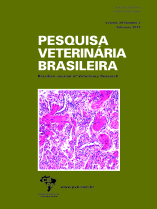 |
|
|
|
Year 2019 - Volume 39, Number 2
|

|
Efficacy of virginiamycin for the control of periodontal disease in calves, 39(2):112-122
|
ABSTRACT.- Ramos T.N.M., Borsanelli A.C., Saraiva J.R., Vaccari J., Schweitzer C.M., Gaetti-Jjardim Jr. E. & Dutra I.S. 2019. Efficacy of virginiamycin for the control of periodontal disease in calves. Pesquisa Veterinária Brasileira 39(2):112-122. Departamento de Apoio, Produção e Saúde Animal, Faculdade de Medicina Veterinária de Araçatuba, Universidade Estadual Paulista, Rua Clóvis Pestana 793, Cx. Postal 533, Jardim Dona Amélia, Araçatuba, SP 16050‑680, Brazil. E-mail: iveraldo.dutra@unesp.br
Periodontal diseases are multifactorial infectious processes caused by complexes of microorganisms, with damage to health, production, and animal welfare. The aim of the present study was to evaluate the efficacy of virginiamycin in the prevention and control of two early forms of periodontal disease: gingivitis and necrotizing gingivitis. Ten weaned calves, aged four to six months, were permanently kept in a single lot under the same rotational grazing regime in a newly reformed area of Panicum maximum. Five of the calves were orally administered 340mg of virginiamycin (Virginiamycin Group) daily for a period of 18 weeks, while the remaining five calves (Control Group) remained under the same food management but did not receive virginiamycin. During this period, animals underwent 18 weekly evaluations regarding periodontal health, with monitoring and recording of clinical parameters of the eight deciduous incisor teeth on the labial and lingual faces. At approximately two-week intervals, nine collections of subgingival sulcus material from five sites of the four right incisor teeth of each animal were performed and subjected to microbiological evaluation using polymerase chain reaction with primers of 25 microorganisms considered potentially pathogenic. After 1440 periodontal clinical evaluations of incisor teeth of the 10 calves, a total of 395 episodes of gingivitis were recorded, of which 267 occurred in the Control Group and 128 in the Virginiamycin Group. Similarly, 89 episodes of necrotizing gingivitis were recorded; 58 in the Control Group and 31 in the Virginiamycin Group. Comparison of between-group means found significant differences for teeth with gingivitis and necrotizing gingivitis (t test; p<0.05). The total number of teeth with gingivitis (p<0.01) and necrotizing gingivitis (p<0.01) in Control Group was significantly higher than that of gingivitis (p<0.01) and necrotizing gingivitis (p<0.05) in the Virginiamycin Group. There was a positive correlation between total occurrence of gingivitis and necrotizing gingivitis in the Virginiamycin Group by Pearson’s test. Virginiamycin had a protective effect on treated animals compared with the Control Group (OR = 0.36: CI (95%) = 0.27-0.43). In the Control Group, Actinomyces israelli (4.74%), domain Archaea (1.58%), Eikenella corrodens (1.05%), Fusobacterium nucleatum (27.37%), class Mollicutes (5.26%); Porphyromonas endodontalis (5.26%); Porphyromonas gulae (0.53%), Prevotella buccae (6.32%), Prevotella loescheii (3.68%), Prevotella nigrescens (8.42%), Prevotella oralis (1.58%), Tannerella forsythia (0.53%), and Treponema denticola (4.21%) were detected at healthy sites, and gingivitis or necrotizing gingivitis samples. In the Virginiamycin Group, A. israelli (3.41%), domain Archaea (0.98%), F. nucleatum (9.27%), class Mollicutes (4.39%), P. endodontalis (4.39%), P. gulae (0.49%), P. buccae (8.29%), P. loescheii (6.83%), P. nigrescens (15.61%), P. oralis (1.46%), Selenomonas sputigena (0.49%), T. forsythia (0.49%), and T. denticola (2.44%) were detected. In conclusion, virginiamycin administered at a dosage of 340mg/animal/day significantly reduced the occurrence of gingivitis and necrotizing gingivitis in cattle maintained on reformed pastures, and was revealed to have action against periodontal bacterial microbiota considered to be potentially pathogenic. |
| |
|
|
| |
|
 |